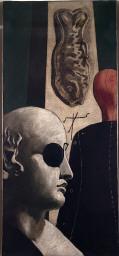The complex relationship between metaphysical legend Giorgio de Chirico and the history of art is explored in a new exhibition in Rome.
'De Chirico And The Museum', commemorating 30 years since the artist's death, looks at how he interacted with his artistic forerunners and their works.
The show features 100 paintings and drawings plus one large sculpture, many of which from De Chirico's personal collection.
It is divided into six sections, starting with 'Mythology and Archaeology', looking at the artist's fascination with the ancient world and neo-classicism.
The next section, 'I d'Apres dai Grandi Maestri', features a collection of works by De Chirico painted in the style of great masters from previous centuries.
'Great Painting' takes an article he wrote in autumn 1919 as its springboard, entitled 'The Return of Craftsmanship'.
Published in a leading art journal of the day, Valori Plastici, the article advocated a return to traditional methods and marked a turning point in his own work, away from the metaphysical movement he helped found.
By the late 1930s, De Chirico had adopted a neo-baroque style, which he partly attributed to Rubens. His work from this period never gained the same critical success as his earlier metaphysical works.
However, the artist thought these were among his best pieces and kept them in his own collection, parts of which have been loaned out by the De Chirico Foundation.
The final section, Neometaphysics, features a selection of metaphysical works De Chirico painted in his later years, many of which backdated ''self-forgeries''.
This was partly a jab at critics hostile to his later style and partly to profit from his early successes. However, in his final years he even denounced some of these works as forgeries by other artists.
De Chirico (1888-1978) had an enormous impact on 20th-century painting.
Founded in 1917, his metaphysical movement influenced artists from Joan Miro to Willem De Kooning, although it lasted a brief decade.
His trademark works feature oddly haunting neo-classical buildings and statues towering above midget figures and empty streets.
A number of De Chirico paintings anticipate surrealism, with their overt air of menace and troubling, mysterious symbols that leave the viewer with more questions than answers.
By painting people not as they appear but as mannequins or semi-abstract symbols, the metaphysical painters aimed to reveal the reality underneath.
'De Chirico And The Museum' is on at the the National Gallery of Modern and Contemporary Art until January 25.










